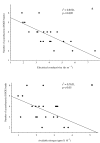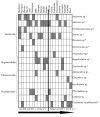Molecular characterization and the effect of salinity on cyanobacterial diversity in the rice fields of Eastern Uttar Pradesh, India
- PMID: 19344531
- PMCID: PMC2680867
- DOI: 10.1186/1746-1448-5-4
Molecular characterization and the effect of salinity on cyanobacterial diversity in the rice fields of Eastern Uttar Pradesh, India
Abstract
Background: Salinity is known to affect almost half of the world's irrigated lands, especially rice fields. Furthermore, cyanobacteria, one of the critical inhabitants of rice fields have been characterized at molecular level from many different geographical locations. This study, for the first time, has examined the molecular diversity of cyanobacteria inhabiting Indian rice fields which experience various levels of salinity.
Results: Ten physicochemical parameters were analyzed for samples collected from twenty experimental sites. Electrical conductivity data were used to classify the soils and to investigate relationship between soil salinity and cyanobacterial diversity. The cyanobacterial communities were analyzed using semi-nested 16S rRNA gene PCR and denaturing gradient gel electrophoresis. Out of 51 DGGE bands selected for sequencing only 31 which showed difference in sequences were subjected to further analysis. BLAST analysis revealed highest similarity for twenty nine of the sequences with cyanobacteria, and the other two to plant plastids. Clusters obtained based on morphological and molecular attributes of cyanobacteria were correlated to soil salinity. Among six different clades, clades 1, 2, 4 and 6 contained cyanobacteria inhabiting normal or low saline (having EC < 4.0 ds m(-1)) to (high) saline soils (having EC > 4.0 ds m(-1)), however, clade 5 represented the cyanobacteria inhabiting only saline soils. Whilst, clade 3 contained cyanobacteria from normal soils. The presence of DGGE band corresponding to Aulosira strains were present in large number of soil indicating its wide distribution over a range of salinities, as were Nostoc, Anabaena, and Hapalosiphon although to a lesser extent in the sites studied.
Conclusion: Low salinity favored the presence of heterocystous cyanobacteria, while very high salinity mainly supported the growth of non-heterocystous genera. High nitrogen content in the low salt soils is proposed to be a result of reduced ammonia volatilization compared to the high salt soils. Although many environmental factors could potentially determine the microbial community present in these multidimensional ecosystems, changes in the diversity of cyanobacteria in rice fields was correlated to salinity.
Figures







Similar articles
-
Cyanobacterial diversity shifts induced by butachlor in selected Indian rice fields in Eastern Uttar Pradesh and Western Bihar analyzed with PCR and DGGE.J Microbiol Biotechnol. 2012 Jan;22(1):1-12. doi: 10.4014/jmb.1106.06016. J Microbiol Biotechnol. 2012. PMID: 22297214
-
Differences in the Cyanobacterial Community Composition of Biocrusts From the Drylands of Central Mexico. Are There Endemic Species?Front Microbiol. 2019 May 3;10:937. doi: 10.3389/fmicb.2019.00937. eCollection 2019. Front Microbiol. 2019. PMID: 31130933 Free PMC article.
-
Matching molecular diversity and ecophysiology of benthic cyanobacteria and diatoms in communities along a salinity gradient.Environ Microbiol. 2000 Apr;2(2):217-26. doi: 10.1046/j.1462-2920.2000.00094.x. Environ Microbiol. 2000. PMID: 11220307
-
Molecular characterization of planktic cyanobacteria of Anabaena, Aphanizomenon, Microcystis and Planktothrix genera.Int J Syst Evol Microbiol. 2001 Mar;51(Pt 2):513-526. doi: 10.1099/00207713-51-2-513. Int J Syst Evol Microbiol. 2001. PMID: 11321098
-
Current states and challenges of salt-affected soil remediation by cyanobacteria.Sci Total Environ. 2019 Jun 15;669:258-272. doi: 10.1016/j.scitotenv.2019.03.104. Epub 2019 Mar 8. Sci Total Environ. 2019. PMID: 30878933 Review.
Cited by
-
Salinity-driven ecology and diversity changes of heterocytous cyanobacteria in Australian freshwater and coastal-marine microbial mats.Environ Microbiol. 2022 Dec;24(12):6493-6509. doi: 10.1111/1462-2920.16225. Epub 2022 Oct 10. Environ Microbiol. 2022. PMID: 36156347 Free PMC article.
-
Acclimation response and ability of growth and photosynthesis of terrestrial cyanobacterium Cylindrospermum sp. strain FS 64 under combined environmental factors.Arch Microbiol. 2022 Feb 5;204(3):165. doi: 10.1007/s00203-022-02772-6. Arch Microbiol. 2022. PMID: 35122519 Free PMC article.
-
Salinity and bacterial diversity: to what extent does the concentration of salt affect the bacterial community in a saline soil?PLoS One. 2014 Sep 4;9(9):e106662. doi: 10.1371/journal.pone.0106662. eCollection 2014. PLoS One. 2014. PMID: 25188357 Free PMC article.
-
Using generalized additive models to investigate factors influencing cyanobacterial abundance through phycocyanin fluorescence in East Lake, China.Environ Monit Assess. 2018 Sep 20;190(10):599. doi: 10.1007/s10661-018-6981-z. Environ Monit Assess. 2018. PMID: 30238229
-
Salt and UV-B induced changes in Anabaena PCC 7120: physiological, proteomic and bioinformatic perspectives.Photosynth Res. 2013 Nov;118(1-2):105-14. doi: 10.1007/s11120-013-9931-1. Epub 2013 Oct 11. Photosynth Res. 2013. PMID: 24113924
References
-
- Zhu JK. Plant salt tolerance. Trends Plant Sci. 2001;6:66–71. - PubMed
-
- Singh RN. Role of Blue-Green Algae in the Nitrogen Economy of Indian Agriculture. ICAR: New Delhi; 1961.
-
- Desikachary TV. Cyanophyta. ICAR: New Delhi; 1959.
-
- Singh SC, Sinha RP, Häder DP. Role of lipids and fatty acids in stress tolerance in cyanobacteria. Acta Protozool. 2002;41:297–308.
LinkOut - more resources
Full Text Sources
Molecular Biology Databases
Research Materials

